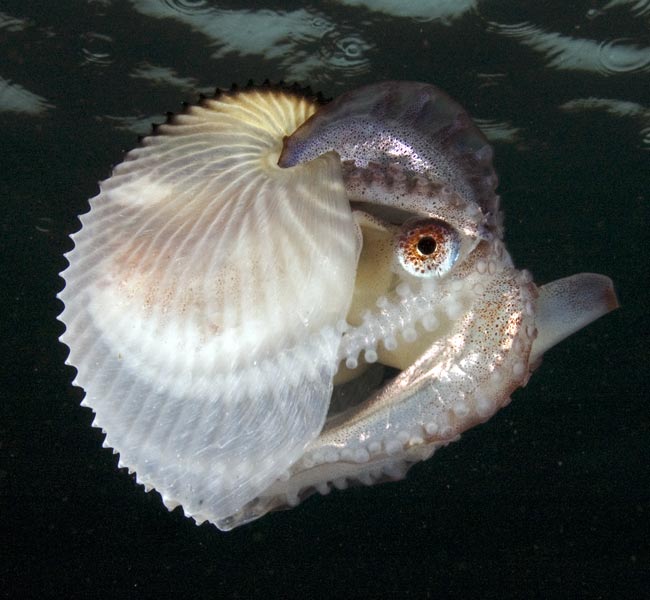
Mystery of the Floating Octopus Solved

As far back as Aristotle, naturalists have wondered why the females of a strange group of octopuses sport a thin, papery shell when plenty of their tentacled cousins are essentially naked, letting all their slime hang out.
Now, observations indicate the so-called Argonaut octopus uses the outer shell to trap an air bubble, allowing her to control her buoyancy in open water and move along with ease. [Photo of the odd octopus]
To determine how female argonauts used their shells to capture air from the surface before diving deeper in the ocean, Julian Finn, the study's lead author and a researcher at the Museum Victoria in Australia, went scuba diving with three female argonauts, caught unintentionally in Japanese fishing nets. (Male argonauts and immature females do not have shells.)
What these argonauts showed him should put to rest decades, even millennia, of speculation, according to Finn.
An old mystery
The genus Argonauta includes several species, whose females can reach up to about 20 inches (50 centimeters) in length, up to eight times longer and 600 times heavier than the males. Finn focused on Argonauta argo, the Greater argonaut.
The female's shell is secreted by webs off her first pair of arms, and held in place by her suckers. It is a fragile, lightweight, single-chambered structure, according to Finn.
Sign up for the Live Science daily newsletter now
Get the world’s most fascinating discoveries delivered straight to your inbox.
In 300 B.C., Aristotle proposed the female argonaut used her shell as a boat and her eight arms to row and sail. Since then, scientists have observed air within the shell and speculated these bubbles could be inconvenient or even harmful, trapping argonauts at the surface and even resulting in mass strandings. Among argonauts kept in aquariums, the bubbles were speculated to have been caused by the aeration system.
In recent decades, speculation that argonauts trapped air to maintain buoyancy gathered momentum, although it remained unconfirmed, according to Finn and co-researcher Mark Norman of La Trobe University in Australia.
To add to the confusion, argonauts are also called "paper nautiluses," because they bear more than a passing resemblance to their distant cousins, the chambered nautiluses. However, instead of eight suckered arms, a nautilus has around 100 suckerless tentacles and, unlike the female argonaut, it is permanently bound to a solid shell. The nautilus uses gas and fluid within its chambered shell to control its buoyancy, Finn said.
Swimming with Argonauts
To figure out what the argonauts were up to, Finn released three of them into Okidormari Harbor in Japan for short periods in January 2006 and observed them.
"To my delight, the argonauts immediately put to rest decades of conflicting opinions, demonstrating their expert ability at obtaining and managing surface-acquired air," he said in a written statement.
He found that if he removed the air bubble from the creature's shell, the animal became unsteady in the water, flailing from side to side as it jetted forward. (An octopus can travel forward by forcing water out its funnel.) Each time he did this, the argonaut would immediately head to the surface, where it jetted across the water, capturing air within its shell. A pair of arms sealed the bubble inside the shell, then the argonaut dove until the buoyancy of the air it had trapped canceled out the weight of the animal in the water. At this point, called neutral buoyancy, the argonaut became capable of swimming at rapid speeds beneath the water's surface.
Buoyancy control is important for organisms living in open water, because otherwise they must expend energy to avoid sinking to the sea floor, according to the researchers.
Scientists also believe that the shell is used to carry eggs; however, none of the three argonauts studied possessed eggs.
The research will be published in the October issue of Proceedings of the Royal Society B.
- 10 Animals That Use Tools
- Dangers in the Deep: 10 Scariest Sea Creatures
- Top 10 Most Incredible Animal Journeys










